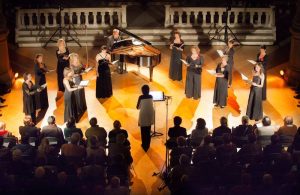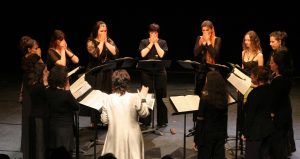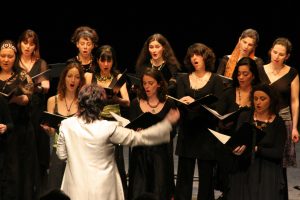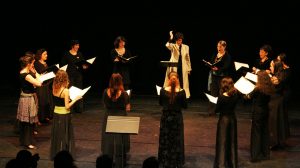Calliope Women’s Chorus, an architectural vision of music
Régine Theodoresco, choir director and teacher, France
When a choir or orchestra director speaks of architecture in music, they are usually referring to the keys provided by a musical analysis that help them construct a performance.
If the director wants to express the idea a bit more concretely, he or she will then speak of the support walls, which are the chords holding up the melodic roof, or perhaps of melodic lines that will build a complex, multi-storied polyphony. They will then describe, using specific musical words (lied, sonata, etc) the general form of the piece, a form not visible as such in the score, but which supports the musical discourse that will develop within the sound space.
That sound space is occupied by the choir, propelled by the choir, modified by the choir. We have all asked ourselves more than once: For a traditional mixed choir, how should we arrange those singers? With SATB from left to right, or SA in front and TB behind, or SA in front but BT in back? Even with the same number of singers and the same piece, the sound result is very different depending on which arrangement is chosen. So, we make the choice with our ears…
For many years, I have worked out different variations, using the shape of the resulting sound as an interpretive tool.
Those coming to a performance of the Calliope Women’s Chorus (Calliope Voix de Femmes), either an a cappella concert or one accompanied by a small instrumental ensemble, will observe that the way we occupy space generally varies from one piece to the next. And if you return to hear the same program, but in a different place, you will be surprised to observe that the arrangement of singers will probably have completely changed. Same thing for a third performance site.
Our concerts are quite varied in their use of space and thus not completely predictable for our audiences. But make no mistake: that variation is an outcome, not just a matter of visual effect or staging.
So if it’s not a question of varying the vocal parts just to fill up the space, nor even simply to take reverberation into account, why these changes, these different arrangements of the singers?
For me and my group (and my groups, as I always operate in pretty much the same way), it’s a question of constructing a unique spatialized performance, in symbiosis with a particular place, reinforcing the work’s principal musical themes by the utilization of the acoustic space.
We all know that, thanks to the work we’ve done in advance, getting to know the score, a mental image has been created that will guide us throughout the rehearsal process. As is true for many musicians, the sound image running around in my head, to the point of obsession, is difficult to explain to someone not directly involved. It’s a question of sound, but what sound, what kind of sound? For me, I know, I sense, that that sound image possesses a density, a thickness, a specific spatial form. Work on the score brings out the contours, which have as much to do with feelings as they do with the desire for the sound. But how to make this sound structure appear, and most of all, how to work on this factor?
I will use a very simple example to illustrate my remarks: The Ave Maria by Zoltán Kodály (for three voices), which alternates between the low vocal line alone (third voice), followed by simultaneous punctuations by the two other voices, in parallel thirds (1st and 2nd voices). I want to clearly hear the deep voices, very homogeneous, but not too dense, with space, and a good balance between the harmonics, and the responses a bit more distant, with the piano thirds a bit farther away, and above all, treated like a single entity.
In rehearsal, I start out arranging the sections in a way that seems to me like a good base, connected to the work’s predominant musical themes. I will put the third voice part singers in the center, and mix the first and second voices together, dispersed here and there.
Then in the concert hall, I first decide where to put the third voices: In a single row, in two? At what distance should the singers stand apart laterally or depth-wise, or even what height should there be between rows? (You would be surprised to hear the noticeable change in overall sound made by even a 50 centimeter difference.) Where should each singer be placed within her section? It will depend on the location’s sound perspective lines. Then I place the other singers on each side of the main theme voice, in two diagonal rows behind and in staggered rows, balancing their power. In another location, with different acoustics, I might decide to place them behind the singer of the theme, on risers or steps, in a one-row semi-circle around the third voice or scattered among the audience.
Because I know well the voice of each performer, what they can give me, and the exact effect I want to obtain, the process goes more quickly than might be expected. However, sometimes it stymies me. I know I can do better, get closer to my mental image, and with more comfort for the singers. In that case, one must step back, look around, and take one’s cues from the characteristics of the place (in a church, behind or in front of the chancel screen? behind or in front of the altar?) Same question for the steps? If one is on a stage: How far from the curtains in the wings, from the backdrop, etc.) An optimal solution can almost always be found. This step requires great adaptability on the part of the singers, an ability to rehearse the same song several times in a row – with the same strength, articulation, etc. so that reliable comparisons can be made – and significant musical autonomy (so that I can go listen to them from the audience…).
I intentionally selected an example piece where the stakes were clear. But I can work in this way, with longer, more compex works, making strong musical choices: Is the fugue passage (which, for more clarity, would require a priori a spacial arrangement grouped by voice part) incompatible with the homophonic passage, (which might require a complete mixing of the voices)? It will then be necessary to resolve these contradictions! It’s fascinating, always something new.
For the audience, the sound experience is very diversifed, even unnerving: One will receive the sound head-on, for more power, or alternatively, in a softer, more envelopping way, from a sound source that can be either broad or focused, dense, or scattered, diffuse or compact.
In conclusion, consistency between the sound object to be created and the characteristics of the space as a parameter in its own right (comparable to the choice of instrumentation), constitutes the foundation of an architectural interpretation.
 Originally trained as a pianist, Régine Théodoresco later transitioned first to orchestral conducting, then to choral direction. She has enjoyed a double career as both a performer and pedagogue. She created the choir direction training program at the Pôle d’enseignement Supérieur de Bretagne – Pays de Loire (Higher Education Center of Brittany – Loire Region) when it opened in 2011 and works with future Conservatory teachers as part of the CEFEDEM Rhône-Alpes. (Translator’s note: CEFEDEM Centre de Formation des Enseignants de la Danse et de la Musique, a training center in danse and music for educators). During her 20 years as director of the “Calliope Women’s Chorus” professional ensemble, she has obtained numerous recording rewards. Régine Théodoresco has served on many national and international juries.
Originally trained as a pianist, Régine Théodoresco later transitioned first to orchestral conducting, then to choral direction. She has enjoyed a double career as both a performer and pedagogue. She created the choir direction training program at the Pôle d’enseignement Supérieur de Bretagne – Pays de Loire (Higher Education Center of Brittany – Loire Region) when it opened in 2011 and works with future Conservatory teachers as part of the CEFEDEM Rhône-Alpes. (Translator’s note: CEFEDEM Centre de Formation des Enseignants de la Danse et de la Musique, a training center in danse and music for educators). During her 20 years as director of the “Calliope Women’s Chorus” professional ensemble, she has obtained numerous recording rewards. Régine Théodoresco has served on many national and international juries.
Translated by Anita Shaperd, USA



